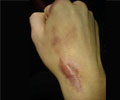Combining gene therapy with an extra boost of the same stem cells the body already uses to repair itself can help speed up the healing of burns.

"As we get older, it is harder for our wounds to heal," says John W. Harmon, M.D., a professor of surgery at the Johns Hopkins University School of Medicine, who will present his findings to the American College of Surgeons' Surgical Biology Club on Sunday at 9 a.m. "Our research suggests there may be a way to remedy that."
To heal burns or other wounds, stem cells from the bone marrow rush into action, homing to the wound where they can become blood vessels, skin and other reparative tissue. The migration and homing of the stem cells is organized by a protein called Hypoxia-Inducible Factor-1 (HIF-1). In older people, Harmon says, fewer of these stem cells are released from the bone marrow and there is a deficiency of HIF-1. The protein was first discovered about 15 years ago at Johns Hopkins by Gregg L. Semenza, M.D., Ph.D., one of Harmon's collaborators.
Harmon and his colleagues first attempted to boost the healing process in mice with burn wounds by increasing levels of HIF-1 using gene therapy, a process that included injecting the rodents with a better working copy of the gene that codes for the protein. That had worked to improve healing of wounds in diabetic animals, but the burn wound is particularly difficult to heal, and that approach was insufficient. So they supplemented the gene therapy by removing bone marrow from a young mouse and growing out the needed stem cells in the lab. When they had enough, they injected those supercharged cells back into the mice.
After 17 days, there were significantly more mice with completely healed burns in the group treated with the combination therapy than in the other groups, Harmon says. The animals that got the combination therapy also showed better blood flow and more blood vessels supplying the wounds.
Harmon says a wound treatment like this that uses a patient's own cells is promising because the patient would be less likely to reject them as they would cells from someone else. Meanwhile, he says, HIF-1 gene therapy has been safely used in humans with sudden lack of blood flow to a limb.
Advertisement
USING STEM CELLS TO PROMOTE NERVE REGENERATION
Advertisement
Johns Hopkins researchers from the Department of Plastic and Reconstructive Surgery report that a type of stem cell found easily in fat cells and also in bone marrow promoted nerve regeneration in rats with paralyzing leg injuries and in some of the rodents that received hind-leg transplants.
The findings mark a step forward in understanding how mesenchymal stem cells (MSCs) may improve nerve regeneration after injury and limb transplant, while potentially minimizing the need for lifelong immunosuppression after reconstructive surgery to replace a lost limb, say study leaders W.P. Andrew Lee, M.D., and Gerald Brandacher, M.D. Such immunosuppressive drug therapy carries many unwanted side effects.
"Mesenchymal stem cells may be a promising add-on therapy to help damaged nerves regenerate," says John Pang, a medical student at the Johns Hopkins University School of Medicine, who is expected to present the findings on Wednesday at 12:45 p.m. "We obviously need to learn much more, but we are encouraged by what we learned from these experiments."
MSCs most frequently become bone, cartilage and fat in the bodies of mammals, and researchers have been able to coax them in test tubes into becoming nerve cells and skin that lines blood vessels and tissue.
Notably, MSCs are not recognized by the body as foreign, making them less likely to trigger an immune system response or attack. Instead, these stem cells appear to secrete proteins that suppress the immune system in specific ways. Pang says it is those properties researchers hope to harness and use to not only regenerate nerve cells, but also to help transplant patients avoid immunosuppressant drugs.
The Johns Hopkins team notes that harvesting MSCs is a relatively simple procedure, because accessible stores are found in body fat. They can also be extracted from bone marrow, a slightly more complicated process.
The Johns Hopkins researchers experimented with three groups of rats: those whose femoral nerves were cut and repaired; those that received a hind-leg transplant from the same biological type of rat; and animals that received a transplant from a different type. Some rats had MSCs injected directly into the sciatic nerve, while others received them intravenously into the bloodstream.
After 16 weeks, the researchers say the rats with severed and repaired nerves treated with MSCs showed significant improvements in nerve regrowth and nerve signaling. Those with transplants from similar rats appeared to also show benefit. The rats whose transplants came from dissimilar rodent types - the situation most similar to a human transplant from a cadaver - rejected their new limbs.
Pang's collaborators on this research include Gabriel A. Brat, M.D.; Zuhaib Ibrahim, M.D.; Eric Wimmers, M.D.; Georg J. Furtmüller, M.D.; Lehao Wu, M.D.; Christoph Wallner, B.S.; Joani Christensen, B.A.; Johanna Grahammer, B.S.; Erin Rada, M.D.; Nance Yuan, B.S.; Alexandros Afthinos, B.S.; Mohammed Alrakan, M.D.; Michael Kimmelman, B.S.; Stefan Schneeberger, M.D.; and Damon Cooney, M.D., Ph.D.
Johns Hopkins Medicine (JHM), headquartered in Baltimore, Maryland, is a $6.7 billion integrated global health enterprise and one of the leading health care systems in the United States. JHM unites physicians and scientists of the Johns Hopkins University School of Medicine with the organizations, health professionals and facilities of The Johns Hopkins Hospital and Health System. JHM's vision, "Together, we will deliver the promise of medicine," is supported by its mission to improve the health of the community and the world by setting the standard of excellence in medical education, research and clinical care. Diverse and inclusive, JHM educates medical students, scientists, health care professionals and the public; conducts biomedical research; and provides patient-centered medicine to prevent, diagnose and treat human illness. JHM operates six academic and community hospitals, four suburban health care and surgery centers, and more than 30 primary health care outpatient sites. The Johns Hopkins Hospital, opened in 1889, was ranked number one in the nation for 21 years in a row by U.S. News & World Report.
Source-Newswise














